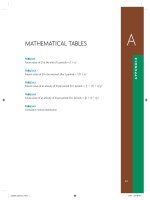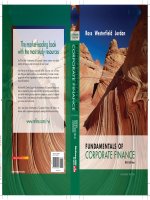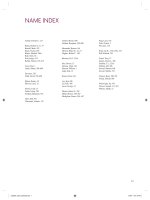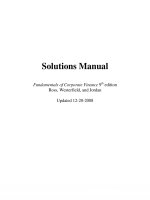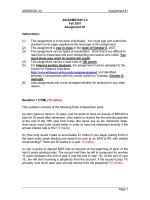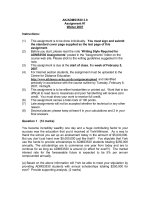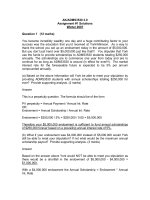exam solution 6 fundamentals of corporate finance, 4th edition brealey
Bạn đang xem bản rút gọn của tài liệu. Xem và tải ngay bản đầy đủ của tài liệu tại đây (141.76 KB, 7 trang )
Name
Section
ID #
Professor Sam Alagurajah’s Section A (Tues. 2-5 pm)
Professor Sam Alagurajah’s Section D (Wed. 7-10 pm)
Professor Lois King’s Section C (Wed. 4-7 pm)
AK/ADMS 3530.03 Finance Midterm Exam
Summer 2007
June 16, 2007
Type A Exam
This exam consists of 30 multiple choice questions and carries a total of 100
points. Choose the response which best answers each question. Circle your
answer below, and fill in your answers on the bubble sheet. Only the
bubble sheet is used to determine your exam score. Please do not forget to
write your name and ID # both at the top of this cover page and on the bubble
sheet. Also please write the type of your exam (A or B) on the bubble sheet.
Please note the following points:
1) Read the questions carefully and use your time efficiently.
2) Choose the answers that are closest to yours, because of possible
rounding.
3) Keep at least 2 decimal places in your calculations and final answers,
and at least 6 decimal places for the interest rate in Question 8.
4) The 20 “Numerical questions” are worth 4 points each.
5) The 10 “Conceptual questions” are worth 2 points each.
6) Unless otherwise stated, interest rates are annual, and bonds pay
semi-annual coupons and have a face value (or par value) of $1,000.
7) You may use the back of the exam paper as your scrap paper.
Numerical questions # 1- 20 (4 points each)
1. How much will be in an account after 3 years if the initial deposit was $10, and which
earned an APR of 10% compounded quarterly for the 3 years?
A)
$10.77
B)
$13.31
C)
$13.45
D)
$31.38
2. If I promise to pay you $1,800 nine years from now in return for a loan of $1,000
today, what is the effective annual interest rate for this agreement?
A)
5.26%
B)
6.75%
C)
9.00%
D)
10.00%
Page 1 of 7
3. In June 2007, the posted mortgage rate at CIBC was 6% for a 6-year term. What is the
monthly interest rate? Use 6 decimal places in your calculations. (Remember that
mortgages are compounded semi-annually)
A)
0.4939%
B)
0.5000%
C)
0.5061%
D)
6.0900%
4. How much can be accumulated for retirement if $1500 is deposited annually,
beginning today, and the account earns 9% interest compounded annually for 40 years?
A)
$ 17,558.
B)
$506,824.
C)
$552,438.
D)
$802,876
5. What is the effective annual rate on a deposit of $5,000 made ten years ago if the
deposit is worth $9,948.94 today? The deposit pays interest semi-annually.
A)
3.50%
B)
6.76%
C)
7.00%
D)
7.12%
6. Assume your uncle recorded his salary history during a 40-year career and found that
it had increased ten-fold (i.e., his salary at the end of his career was 10 times his salary at
the beginning). If inflation averaged 5% annually during the period, how would you
describe his purchasing power, on average?
A)
His purchasing power remained on par with inflation.
B)
He “beat” inflation by nearly 1% annually.
C)
He “beat” inflation by slightly over 2% annually.
D)
He “beat” inflation by 5% annually.
7. How much interest will be earned during the third year if $1,000 is deposited that
earns 8% interest compounded annually?
A)
$ 70.00
B)
$ 93.31
C)
$105.62
D)
$140.00
Page 2 of 7
8. A credit card account that charges interest at the rate of 1.25% per month would have
an annually compounded rate of _______ and an APR of _______.
A)
16.08%; 15.00%
B)
14.55%; 16.08%
C)
12.68%; 15.00%
D)
15.00%; 14.55%
9. You decide to sell your car and someone has offered you four equal annual payments
of $3,100, beginning two years from today. Your alternative is to sell your car today for
$9,000 cash. Assuming everything else is equal, should you accept the offer of the four
equal payments (the prevailing rate of interest is 10%)?
A)
Yes; present value is $9,827.
B)
Yes; present value is $11,372.
C)
No; present value is $8,933.
D)
No; present value is $8,121.
10. How much more is an annual perpetuity of $1,000 worth than an annual annuity of
the same amount for 20 years? Assume a 9% interest rate and cash flows are at end of
each year.
A)
$297.
B)
$1,486.
C)
$1,983.
D)
$2,000.
11. Two years ago bonds were issued with 10 years until maturity, selling at par, and a
7% coupon. Interest is paid semi-annually. If market interest rates for that grade of bond
are currently 8.25%, what will be the price of these bonds?
A)
$700.00
B)
$916.00
C)
$927.84
D)
$987.50
12. What is the yield to maturity of a bond with the following characteristics? Coupon
rate is 8% with semi-annual payments, current price is $960, three years until maturity.
A)
2.39%
B)
4.78%
C)
9.57%
D)
12.17%
Page 3 of 7
13. What is the current yield of the following bond: it has 10 years until maturity, sells
for $1033, and has a face value of $1000 and a 6% coupon rate (paid semi-annually).
A)
2.39%
B)
4.78%
C)
9.57%
D)
12.17%
14. BCE was recently been bought out by a U.S. private equity firm who levered the
company and now BCE is having cash flow problems. Its existing bonds have the
following terms: 6% coupon, $1000 face value and they mature in 10 years. Bonds of
equivalent risk yield 12%. BCE is asking the bondholders to swap their existing bonds
into 5 year zero-coupon bonds with a face value of $1000. Assuming BCE will not be in
default during the next 10 years, should existing bondholders accept the deal?
A) No, because the existing bonds are worth more.
B) Yes, because, the zero coupon bonds are worth more.
C) Yes, because the zero coupon bonds have a shorter 5 year maturity.
D) No, because zero coupon bonds do not pay interest.
15. You bought a bond with a 7% annual coupon rate four years ago when market
interest rates for similar bonds was 6%. The bond had an original maturity of 10 years
and a par value of $1000. Today, the yield to maturity of the bond has increased to 8%
annually. If you sell the bond today, what would be your annual rate of return over the
past 4 years? The bond pays coupons semi-annually. Assume coupons are not reinvested.
A) 3.50%
B) 3.69%
C) 7.33%
D) 14.77%
16. How much of a stock’s $25 price is reflected in the PVGO if it expects to earn $3 of
earnings per share next year, and has a required rate of return of 14%?
A) $3.57.
B) $5.00.
C) $21.43
D) $22.00
17. TD Bank’s earnings and dividends are expected to grow at a rate of 10% during the
next 2 years, at 8% in the third year, and at a constant rate of 6% thereafter. If last
dividend paid was $1 and the required rate of return on its common stock is 12%. How
much should you pay today for one share of TD Bank?
A)
$19.31
B)
$24.66
C)
$25.97
D)
$28.02
Page 4 of 7
18. How much should you pay today for a stock per share that offers a constant growth
rate of 9% for dividends, requires a 12% rate of return, and is expected to sell for $40 one
year from now?
A) $35.71
B) $38.83
C) $41.20
D) $44.80
19. What should be the annual dividend yield for Year 3 of a stock if a $4 dividend per
share was just paid, the stock has an annual required rate of return of 18%, and a constant
dividend growth rate of 6%?
A) 6.35%
B) 7.57%
C) 12.00%
D) 13.48%
20. What is the implied constant growth rate of dividends for a stock currently priced at
$25, that just paid a dividend $2 per share, and has a yearly expected rate of return of
18%?
A) 3.41%
B) 9.26%
C) 10.0%
D) 13.5%
Conceptual questions # 21 - 30 (2 points each)
21. A stream of equal cash payments lasting forever is termed:
A)
An annuity.
B)
An annuity due.
C)
An installment plan.
D)
A perpetuity.
22. Given a set future value (greater than zero), which of the following will contribute to
a lower present value?
A)
Higher discount rate.
B)
Fewer time periods.
C)
Less frequent discounting.
D)
Lower discount factor.
Page 5 of 7
23. If we assume that in the market place the nominal rate of interest is greater than that
real rate of interest we can normally assume that
A) there is deflation in the economy
B) the CPI is increasing
C) Price of the average home is going down
D) No one wants to borrow money as the rates are too high
24. Which of the following theories is generally supported by the principles of
compound interest, assuming we invest in interest bearing securities?
A)
The longer you invest the more likely your investment will grow.
B)
Whether you invest for your retirement early or late in life are irrelevant.
C)
The rate at which your retirement investment grows is irrelevant.
D)
The later in life you invest the better off you will be.
25. Which of the following is correct for a CCC-rated bond, compared to a BBB-rated
bond?
A)
The CCC bond must have protective covenants.
B)
The CCC bond must have a sinking fund provision.
C)
The CCC bond must offer a higher coupon rate.
D)
The CCC bond must offer a higher yield to maturity.
26. Which of the following bond features would be attractive to the bond investor and
allow him/her to lend funds at a lower rate?
A)
A call provision.
B)
A sinking fund provision.
C)
A subordination provision.
D)
A zero coupon feature.
27. Which of the following is correct for a bond currently selling at a premium?
A) Its current yield is higher than its coupon rate.
B) Its current yield is lower than its coupon rate.
C) Its yield to maturity is higher than its coupon rate.
D) Its default risk is extremely low.
28. The maximum number of shares that a company is permitted to issue, as specified in
the firm’s articles of incorporation is called:
A)
authorized share capital
B)
issued share capital
C)
issued and outstanding share capital
D)
additional paid-in capital
Page 6 of 7
29. Bank of Montreal had fallen upon hard times due to a rogue trader and dividends on
their non-cumulative, preferred stock were not paid for three years. They are now able to
resume the dividend payments. Which of the following is true?
A)
Common shareholders must now receive three years' worth of dividends.
B)
Preferred shareholders must now receive three years' worth of dividends.
C)
The corporation must close if preferred shareholders are not paid.
D)
Common shareholders have not received dividends for three years.
30. The form of market efficiency that best describes the inability of professional
portfolio managers to outperform the market is:
A)
strong-form efficiency
B)
semi-strong form efficiency
C)
weak-form efficiency
D)
None of the above. All professional portfolio managers outperform the
market.
********* end of exam ***********
Page 7 of 7
